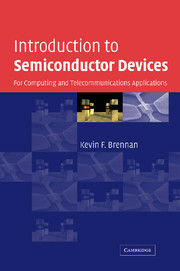Book contents
- Frontmatter
- Contents
- Preface
- List of physical constants
- List of materials parameters for important semiconductors, Si and GaAs
- 1 Semiconductor fundamentals
- 2 Carrier action
- 3 Junctions
- 4 Bipolar junction transistors
- 5 JFETs and MESFETs
- 6 Metal–insulator–semiconductor structures and MOSFETS
- 7 Short-channel effects and challenges to CMOS
- 8 Beyond CMOS
- 9 Telecommunications systems–an overview
- 10 Optoelectronic devices – emitters, light amplifiers, and detectors
- 11 Transistors for high frequency, high power amplifiers for wireless systems
- References
- Index
7 - Short-channel effects and challenges to CMOS
Published online by Cambridge University Press: 05 June 2012
- Frontmatter
- Contents
- Preface
- List of physical constants
- List of materials parameters for important semiconductors, Si and GaAs
- 1 Semiconductor fundamentals
- 2 Carrier action
- 3 Junctions
- 4 Bipolar junction transistors
- 5 JFETs and MESFETs
- 6 Metal–insulator–semiconductor structures and MOSFETS
- 7 Short-channel effects and challenges to CMOS
- 8 Beyond CMOS
- 9 Telecommunications systems–an overview
- 10 Optoelectronic devices – emitters, light amplifiers, and detectors
- 11 Transistors for high frequency, high power amplifiers for wireless systems
- References
- Index
Summary
Though long channel MOSFET devices are an excellent means of describing how MOSFETs work, they are rarely used nowadays. In order to increase the number of active devices on a chip and thus improve its functionality, MOSFET device structures have undergone continued miniaturization. The long channel theory developed in Chapter 6 is valid only for devices that have channel lengths greater than about 1-2 μm. Present state-of-the-art MOSFETs used in digital integrated circuits are very much smaller than this. At the time of this writing, major integrated circuit manufacturers are producing commercial products with 0.13 μm gate lengths. Devices with only 0.1 μm gate lengths are already in the design stage. Therefore, state-of-the-art devices are very different from the long channel MOSFETs discussed in Chapter 6. In this chapter we examine the processes in state-of-the-art Si based MOSFETs and discuss how reduction in the gate length influences device behavior.
Short-channel effects
There are many complications that arise as MOSFET devices are miniaturized. These can be summarized as arising from material and processing problems or from intrinsic device performance issues. As the device dimensions shrink it is ever more difficult to perform the basic device fabrication steps. For example, as the device dimensions become smaller and the circuit denser and more complex, problems are encountered in lithography, interconnects, and processing. Different intrinsic device properties are affected by device miniaturization. The class of effects that alter device behavior that arise from device miniaturization are generally referred to as short-channel effects.
- Type
- Chapter
- Information
- Introduction to Semiconductor DevicesFor Computing and Telecommunications Applications, pp. 169 - 187Publisher: Cambridge University PressPrint publication year: 2005



